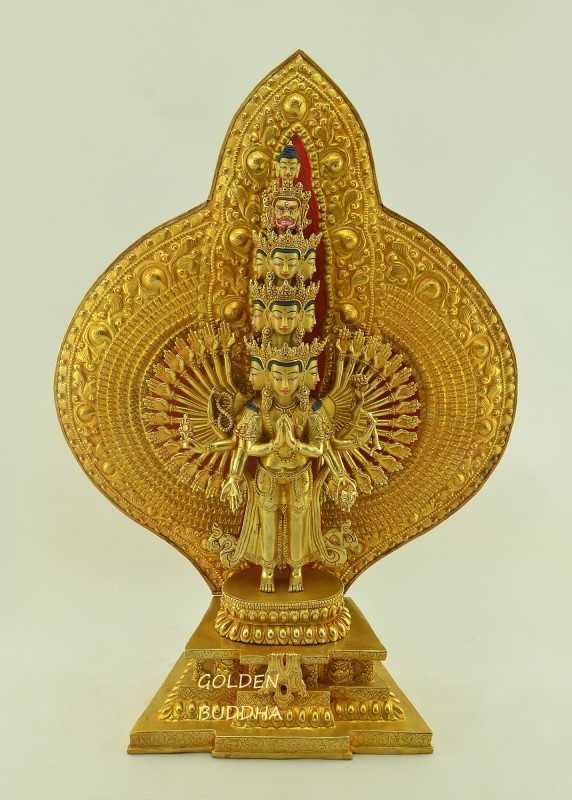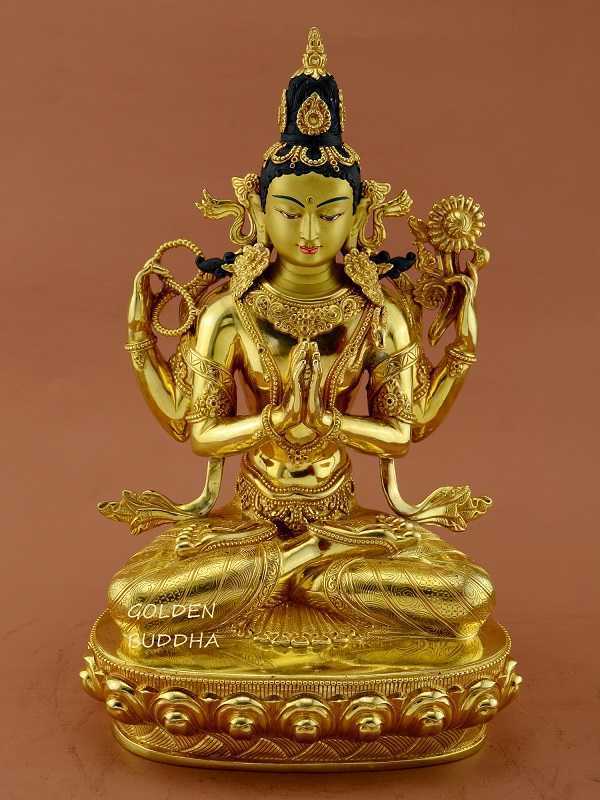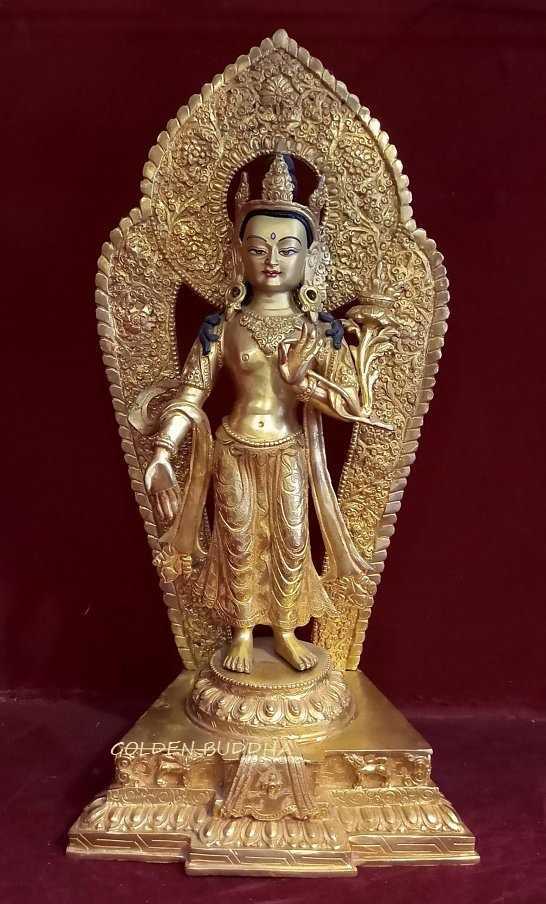Compassion is a central component of Buddhism and Avalokiteshvara is synonymous with compassion. Additionally, Avalokiteshvara is known as the “Bodhisattva of Compassion” and embodies the compassion of all the Buddhas. As a result, Avalokiteshvara statues are core components of Buddhist art. As Buddhism gained in popularity and spread eastwards out of India, Avalokiteshvara would remain an integral component. Indeed, the evolution of Avalokiteshvara statues tell an intriguing story.
Cultural Variations of Avalokiteshvara Statues
In East Asia and Tibet, cultural expectations perceived compassion differently. As a result of the changes made to the embodiment of compassion, Avalokiteshvara statues would have many variations. Indeed, a universal virtue such as compassion is not as uniformly perceived as one would think. As a result, each Avalokiteshvara statue had various physical characteristics imposed on it according to the geographical location.
These cultural variations would sometimes result in Avalokiteshvara statues with superhuman features. Additionally, these changes to the embodiment of compassion would be both masculine and feminine. As a result, in Tibet the cultural adaptation of Avalokiteshvara images was male and in East Asia Avalokiteshvara was an elegant female. However, in both countries they also accepted the 1000 armed and 11 headed Avalokiteshvara statue. But which embodiment was the preferred version of Avalokiteshvara?
1000 Armed Avalokiteshvara Statue with 11 heads
Buddhist Mandate of Avalokiteshvara
The Buddhist canon states that “bodhisattvas can assume whatever gender and form is necessary to liberate beings from ignorance and dukkha (suffering)”. As a result, the physical forms of Avalokiteshvara images would fluctuate widely for practical purposes and not only cultural reasons.
The different forms of Avalokiteshvara allowed the bodhisattva to work more efficiently to free all sentient life from suffering. As a result, Avalokiteshvara worked more productively with superhuman form. However, the ignorance of sentient life would prove to be very stubborn. Therefore, even the most powerful Buddhist deity had met his match.
1000 Armed Avalokiteshvara Story
The Avalokiteshvara story is based on a solemn vow to free all sentient life from suffering. As a result, Avalokiteshvara toiled night and day to assist all sentient life. However, he soon realized that many of the beings he had once saved had gone back to their evil ways. As a result, the body of Avalokiteshvara imploded into thousands of pieces!
Fortunately, Amitabha Buddha arrived and put Avalokiteshvara back together again. However, during the resurrection of Avalokiteshvara, Amitabha endeavored to relieve the intense anguish and futility of Avalokiteshvara’s tremendous vow.
Therefore, Avalokiteshvara received a special embodiment which enabled him to work more efficiently. Indeed, Amitabha Buddha had given Avalokiteshvara 1000 arms and 11 heads! First, Amitabha placed his own head on top so he could personally provide assistance. Next, the head of Vajrapani (Bodhisattva embodying the Buddha’s power) would be directly under Amitabha and the other nine heads below Vajrapani would be Avalokiteshvara’s.
11 Heads of Avalokiteshvara Statue
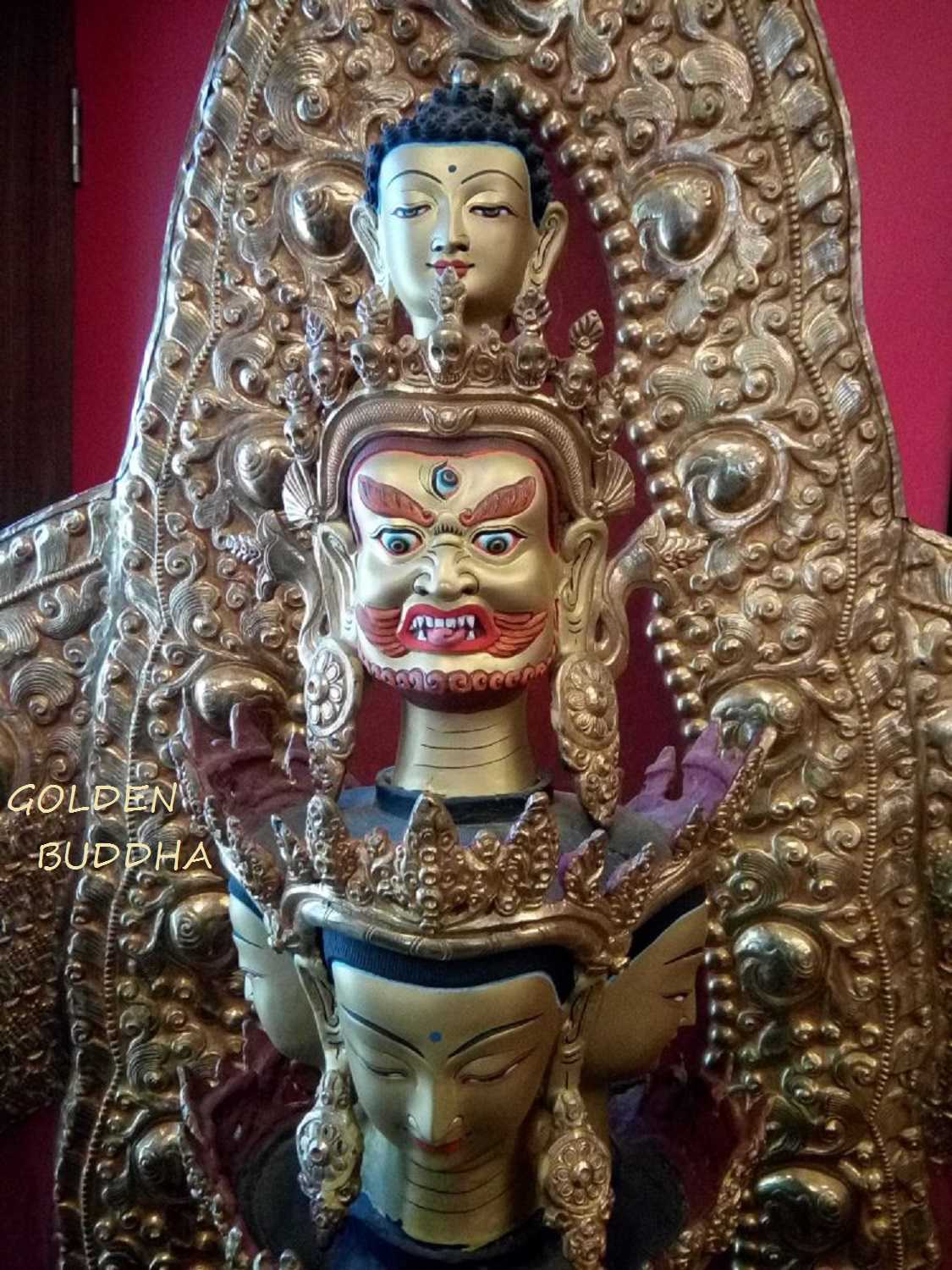
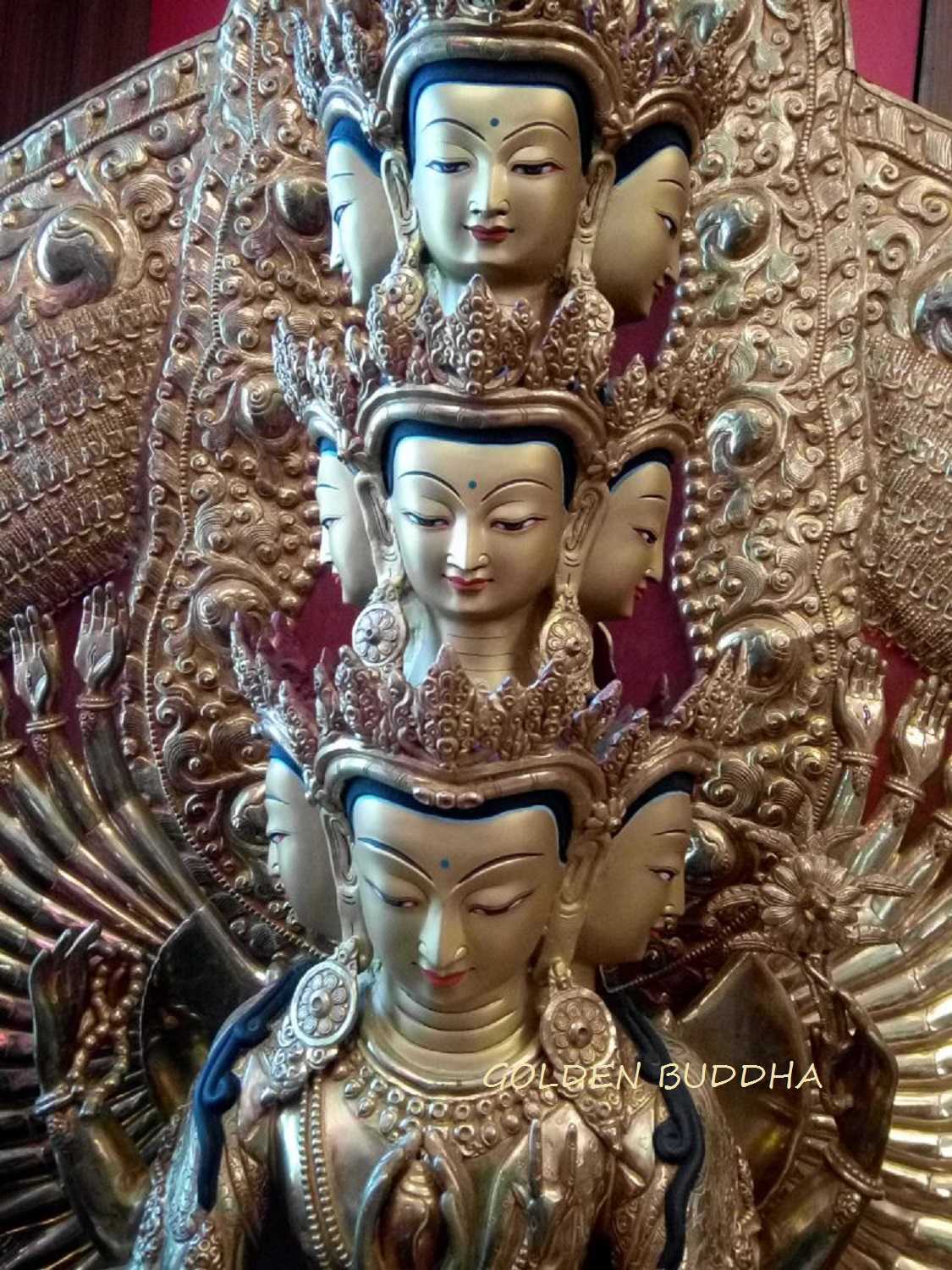
Furthermore, on the palm of each of Avalokiteshvara’s 1000 hands is an eye which symbolizes the joining of the five method perfections (fingers) with the sixth perfection of wisdom (eye).
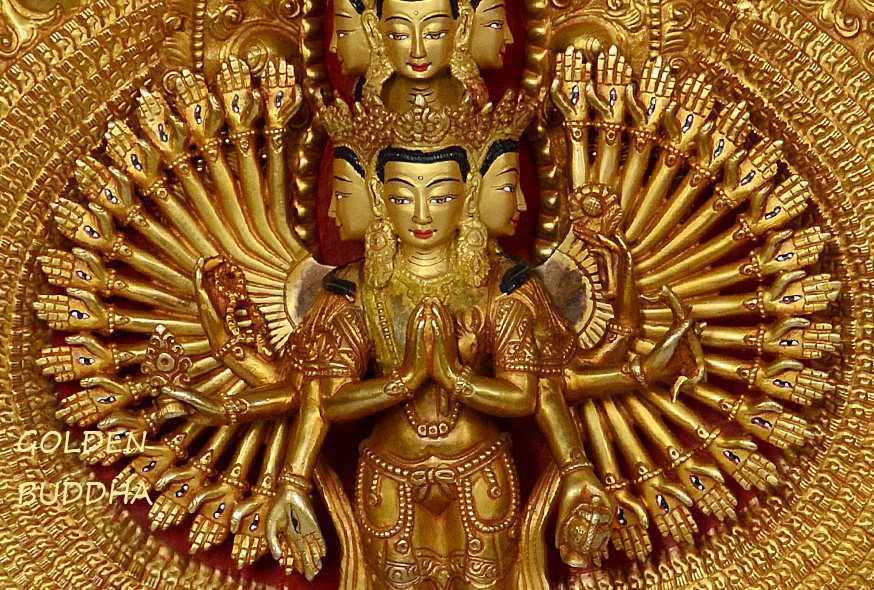
Avalokiteshvara Images in Tibetan Buddhism
The Tibetan king made Buddhism the national religion of Tibet in the 8th century. As a result, Avalokiteshvara statues would become an important component of Tibetan Buddhist art. Additionally, Avalokiteshvara’s integration was not only into Tibet but also other countries that accepted Tibetan Buddhism. This includes Bhutan, Nepal and also Mongolia.
The bodhisattva Avalokiteshvara sculpture in Tibet (known as Chenrezig) would have four arms, each representing an important Buddhist virtue. As a result, each of his 4 arms stands for one of the four immeasurables – compassion, loving kindness, equanimity and appreciative joy. Indeed, Avalokiteshvara images would also receive a wrathful embodiment in Tibet with 6 arms and 3 faces known as Hayagriva or the “Horse Necked One”. Furthermore, Avalokiteshvara has wrathful emanation known as Black Mahakala who has one face and six arms.
Chenrezig statues hold the 108 mala beads in the upper right hand and the symbol for enlightenment (lotus blossom) in his upper left hand. Furthermore, he holds the cintamani “wish fulfilling jewel” in front of his chest between his two hands. Additionally, the Avalokiteshvara mantra would become well established in Tibet and in other Buddhist counties.
Four Armed Avalokiteshvara Statue
Avalokiteshvara Mantra
Chenrezig is constantly chanting the Avalokiteshvara mantra to assist sentient life. As a result, he holds the 108 mala beads in the upper right hand. The Avalokiteshvara mantra reveals the secret of obtaining enlightenment. Indeed, the mantra is an important tool to help Avalokiteshvara fulfill his vow and relieve the suffering of all sentient beings.
“Om Mani Padme Hum”
Tibetan Buddhists believe that the 14th Dalai Lama is a living incarnation of Avalokiteshvara. Indeed, the Dalai Lama gives a very inspirational explanation of the mantra of Avalokiteshvara in English. The Dalai Lama presently resides in Dharamshala, India which has become the center of Tibetan Buddhism. His explanation of the Avalokiteshvara Mantra is as follows:
Avalokiteshvara Mantra Meaning:
OM – is a syllable that has its origins in Hinduism and it is thousands of years old. Its textbook definition is similar to saying “amen” during prayers in Abrahamic religions. Furthermore, he explains that phonetically, Om is broken down into 3 letters A-U-M. These three letters symbolize the practitioner’s impure body, speech and mind. In contrast, the three letters also symbolize the pure body, speech and mind of the Buddha. He goes on to say that nobody was born with pure body, speech and mind – including Buddhas. However, everybody can attain them – but how?
MANI – this is a Sanskrit word that translates as “jewel”. His holiness explains that the syllables contained in the word “Mani”, constitute the factors of “method” – altruistic desire to achieve enlightenment. Therefore, the altruistic objective of achieving enlightenment is to enable other sentient life to also become enlightened.
PADME – This Sanskrit word means “lotus” which in Buddhism, symbolizes wisdom. Here, he refers to the wisdom of realizing the true nature of all phenomenon. That being its impermanence, unsatisfactoriness and insubstantiality (no self). He says that acquiring wisdom is essential in order to realize the emptiness of all phenomenon.
HUM – symbolizes the indivisible unity of method and wisdom. Their indivisible nature is imperative to achieve purity.
Avalokiteshvara Path to Enlightenment
When the words are put together and recited “Om Mani Padme Hum” it means that by using the indivisible path of method and wisdom, sentient beings can purify their body, speech and mind to become Buddhas. As a result, they have accomplished the equivalent of entering Nirvana. His holiness then reemphasizes that in the teachings of the Future Buddha Maitreya – “All beings naturally have the Buddha nature in their own continuum.” Therefore, we simply need to develop our Buddha nature that is already inside of us.
Tibetan Avalokiteshvara Statue
Masculine Origin of Avalokiteshvara Statues
In Buddhism, Avalokiteshvara’s compassion is a masculine attribute. In contrast, wisdom is a feminine attribute. It is the primordial union of these two attributes – compassion and wisdom – which constitutes supreme enlightenment. The Buddhist symbol that represents compassion (skillful means) is the vajra. In contrast, the ghanta (bell) symbolizes the feminine aspect of wisdom.
For thousands of years the vajra represented power and strength. In ancient India, army commanders carried the vajra into battle. Additionally, the commanders would use the vajra as a weapon. Furthermore, the guardian deity Indra also wielded the vajra as a mystical weapon.
Male Avalokiteshvara Statues
Tibetan Buddhism is not the only version of Buddhism that perceives compassion as masculine. Additionally, in geographical areas where Theravada Buddhism is the national religion, compassion remains a masculine attribute.
This is evident in many Buddhist countries such as India, Sri Lanka and Cambodia. The Khmer Empire in Cambodia referred to Avalokiteshvara by a different name – Lokeshvara. The Khmer also built over 200 Lokesvara statues at the ancient Khmer Temple at Bayon.
Standing Avalokiteshvara Statue
Subsequent to the completion of the temple in the 13th century, the Khmer Empire fluctuated between Hinduism and Buddhism. Nonetheless, 200 statues of Lokesvara are still standing today and each of the Avalokiteshvara images at Bayon features a smiling human face.
Avalokiteshvara Statues in Cambodia
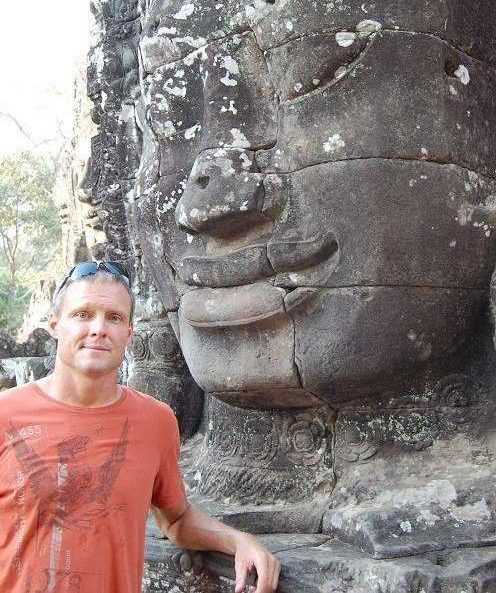
Female Avalokiteshvara Statues in East Asia
As Buddhism gained in popularity during the first millennium and began to spread to the Far East, the Avalokiteshvara story would cross over some well established cultural boundaries. As a result, Avalokiteshvara images, would adapt culturally by changing from masculine to feminine features. Mainly, this is because Chinese culture associates compassion with the female sex rather than male.
Therefore, the attributes of Avalokiteshvara statues would change quite dramatically. Nonetheless, compassion for sentient life would remain the central theme of the Avalokiteshvara story.
However, in China Avalokiteshvara would become distinctly female. Additionally, she would become known as Guanyin. Furthermore, she would become renown throughout China as the “The One who perceives the sounds of the world”. Soon afterwards, East Asia Buddhists in Korea and Japan would follow China’s lead in acceptance of Guanyin.
Special Attributes of Guanyin Statues
Avalokiteshvara statues in China commonly depict Guanyin holding a vase. Additionally, the vase is filled with a special water called the “Dew of Compassion” that she is liberally dispensing. The water is special because it has healing properties that will prolong life and relieve suffering.
In her other hand Guanyin is typically holding a willow branch between her index finger and thumb. The willow branch is used to cure sickness and also fulfill the wishes of her devotees.

Taoist Influence on Avalokiteshvara Statues in China
However, in some parts of China the Avalokiteshvara story is exclusively rooted in Taoism, not Buddhism. Therefore, Guanyin is female because of her affiliation with Taoism and not her association with Buddhism. Additionally, compassion was not necessarily part of her evolution in these parts of China. Instead, it is the eight immortals of the Taoist pantheon which is the origin of Guanyin.
The Tao immortal known as He Xian’gu is the only female member of the Taoist pantheon. Therefore, Guanyin is an emanation of this immortal. Additionally, He Xian’gu lived during the reign of the Tang Dynasty in China.
To be sure, there are also many Chinese Avalokiteshvara images and paintings that display Guanyin more extravagantly with 1000 arms and 11 heads. However, it seems that the preference in East Asia would be for her portrayal as an elegant woman.


